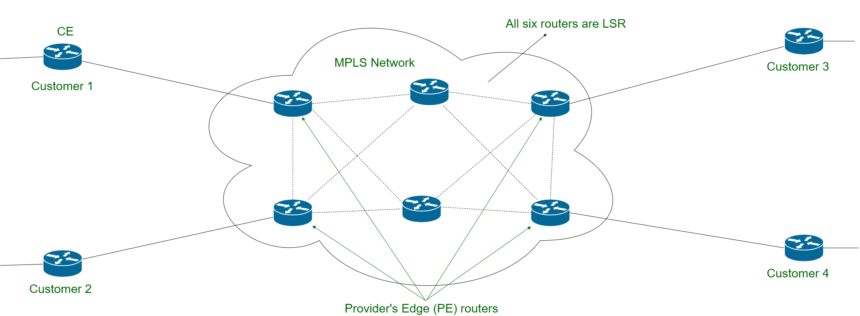Introduction to Multiprotocol Label Switching (MPLS)
MPLS is an efficient networking method that guides data between nodes using brief path labels instead of lengthy network addresses. This approach enhances both speed and control while reducing complexity. Organizations need to understand when to implement multiprotocol label switching for optimized performance. By offering enhanced data handling capabilities, MPLS ensures efficient data routing, minimizes congestion and improves overall network reliability.
With its ability to enhance network efficiency, MPLS is instrumental for companies looking to elevate their network performance and reliability. Given current technological advancements, knowing the appropriate scenarios for adopting MPLS to achieve the utmost benefits is crucial. MPLS can support various applications, from VoIP to large data transfers, making it a versatile solution for modern enterprises.
Advantages of MPLS
- Improved Quality of Service (QoS): MPLS delivers robust QoS functionalities prioritizing urgent data packets, ensuring essential services like VoIP and video conferencing remain uninterrupted. This prioritization helps maintain call quality and video stream consistency, which is critical for business operations that rely on seamless communication.
- Enhanced Security Features: MPLS offers a higher security level than traditional IP routing, making it an excellent choice for organizations requiring secure data transfers. This security is achieved through an additional layer of data encapsulation, creating isolated pathways that restrict unauthorized access and breaches.
- Lower Latency and Faster Data Transfer:MPLS significantly reduces latency by optimizing routing paths, ensuring quicker data transfers crucial for time-sensitive applications. This is particularly beneficial for applications in finance and gaming, where milliseconds can make a significant difference.
- Scalability for Growing Businesses: MPLS can easily accommodate growing network demands, making it an ideal solution for businesses expecting expansion. As enterprises grow and add new branch offices or remote sites, MPLS can flexibly expand to include additional locations without compromising performance or security.
Common Applications of MPLS in Modern Networks
Various industries leverage MPLS’s strengths to meet their specific requirements. Businesses with high reliability and fast connection needs often turn to MPLS. For instance, the financial sector, healthcare providers, and e-commerce platforms heavily rely on this technology. MPLS supports secure, rapid transactions essential for financial institutions and ensures that patient data in healthcare settings is swiftly and securely transmitted.
Healthcare providers use MPLS to ensure patient data is securely and swiftly transferred between hospitals and clinics, maintaining patient privacy and timely medical care. Similarly, e-commerce companies utilize MPLS to guarantee fast and secure transaction processing, enhancing customer satisfaction. By employing MPLS, these industries can meet their specific compliance and performance standards efficiently and effectively.
When to Consider MPLS Over Other Networking Solutions
- Mission-Critical Applications: If your organization runs applications that require guaranteed bandwidth, MPLS is a reliable choice. It ensures consistent performance, which is essential for seamless operations. For manufacturing or real-time transaction processing environments, having a stable and dedicated bandwidth can prevent delays and errors that could lead to significant operational losses.
- Real-Time Data Applications: VoIP and video conferencing heavily depend on uninterrupted data flow. MPLS offers low latency and high reliability, making it ideal for real-time applications. This enables businesses to conduct virtual meetings and collaborate across different geographical locations without experiencing lag or connectivity issues.
- Minimal Latency Environments: In scenarios where every millisecond counts, such as financial trading platforms, MPLS proves invaluable for delivering data with minimal delay. Latency-sensitive applications benefit immensely from MPLS as it provides fast, predictable network paths that enhance the end-user experience and operational accuracy.
MPLS for Enhanced Network Efficiency
Utilizing MPLS for network infrastructure can significantly boost efficiency. It reduces congestion and ensures better bandwidth allocation, vital for companies with multiple branch offices. This is particularly beneficial for industries with extensive geographical spread. For example, multinational corporations can use MPLS to create a cohesive, high-performance network that connects employees and resources around the globe.
MPLS routes traffic more intelligently, avoiding bottlenecks and ensuring a smoother data flow. This results in more effective use of network resources, enhancing overall productivity and user experience. By minimizing data transfer delays and optimizing the use of available bandwidth, organizations can deliver higher-quality services to their users and customers.
Comparing MPLS with Emerging Technologies
While new technologies like SD-WAN are becoming popular, MPLS remains a preferred choice for many due to its proven reliability and security. For organizations that prioritize these aspects, MPLS is often the go-to solution. SD-WAN offers greater flexibility and cost savings through broadband internet connections, but MPLS’s predictable performance makes it indispensable for specific use cases.
Despite the increasing popularity of new technologies like SD-WAN, many still choose MPLS because of its well-established reliability and security. MPLS is frequently the preferred solution for organizations that prioritize these factors. SD-WAN provides more flexibility and cost savings with broadband internet connections, while MPLS’s reliable performance is essential for certain scenarios.
Conclusion: Making the Decision
Whether to implement MPLS within your organization depends on carefully assessing your unique requirements. If your top priorities include enhancing security, ensuring reliable connections, and minimizing latency, MPLS is likely the ideal solution for your network. Evaluating your current and future network needs will allow you to make a well-informed decision. It’s crucial to thoroughly understand the specific demands of your industry and operations to determine if MPLS can effectively meet your performance and security needs.


